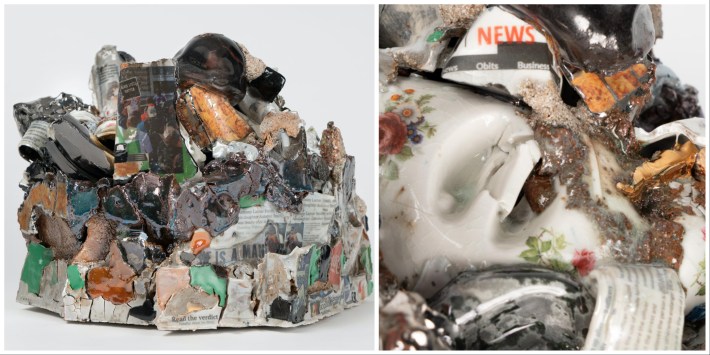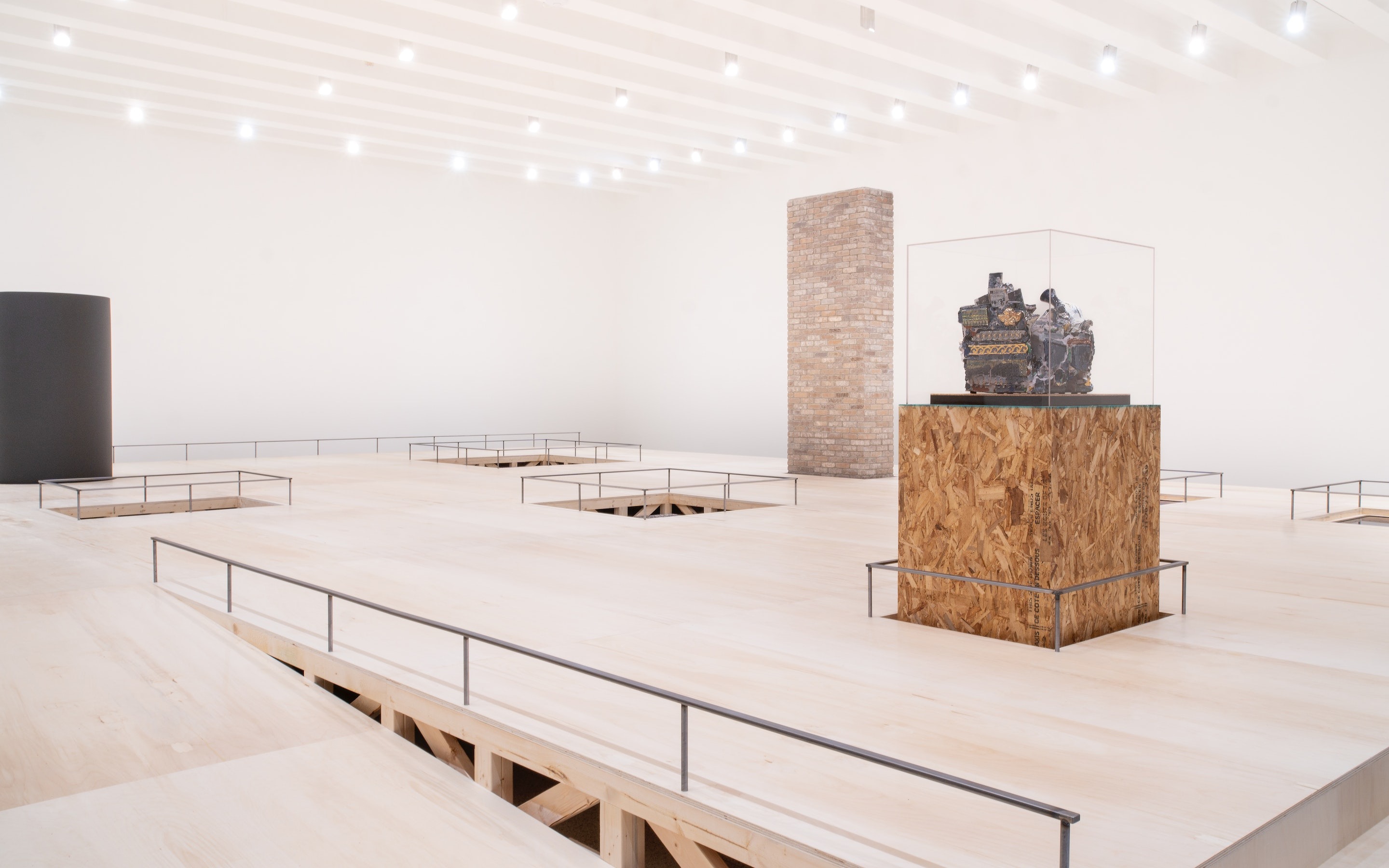At the Acropolis Museum in Athens, Greece, you can wander raised walkways that overlook an archaeological excavation of an ancient Athens neighborhood, with its roads, homes, bath houses, tombs, and its artifacts, like coins and vessels. You can see and feel the quotidian life of those who stood in that very place thousands of years before you.
Memorializing daily activities and their detritus is happening here in Minneapolis, too, in a new exhibit at the Walker Art Museum. Kahlil Robert Irving’s “Archaeology of the Present” is situated on a platform that overlooks simulated streets and artifacts, just on a much nearer timeline.
The gallery at the Walker Art Center is filled with a wooden platform for viewers to walk on, almost like a stage. Cut-outs in the platform reveal artworks at foot level, tilting the axis on which we are accustomed to viewing art.
But first, we encounter a sculpture at eye-level on a plywood plinth, a magpie-like conglomeration of layered ceramic titled Tube & Chimney / Wonder fragments (asphalt | mine media views). It has the look of a pressurized, petrified, and glazed chunk of landfill. Included are a vase with small white flowers, bits of newsprint, screenshots of the web with a New York Times URL and Facebook post visible, a gold cherub, and individual letters spelling out “say her name,” a reference to the phrase honoring Black women killed by police.
Much of this exhibit—if you look closely—seeks to honor Black life and memory, where our society would have it erased and forgotten.
In Streetview | Pool & Paper (Underground star ways), the largest of three black ceramic tile pieces set into the floor, scraps of daily life mingle alongside flecks of shiny gold and battered newspapers: an oversized ceramic version of tree-shaped car air fresheners, brassy gold teeth, and a partial headline from The Chicago Defender newspaper: “Klan Burns ‘K’ on Man’s F[...]”

These three ceramic tile works are inspired by the mosaic floors of ancient Antioch. Aesthetically, they are entirely different. But what Irving drew from the floors in Antioch is the representation of the daily life of the world around them. Irving’s are meant to reference the asphalt of city streets, and the life that happens there. The tiles are imperfect: There are visible are cracks and gaps, just like on any given block of a city.
Asphalt makes another appearance here, in the two-channel video installation inset to another section of the platform, titled Sky View {(for wonder) ‘Snap’}. One video shows a close-up of asphalt streets, with occasional drops of oil or pieces of gum. The video alongside it shows shots of the sky, wisps of thin clouds, or bright puffy ones against dark blue sky. It’s nearly vertigo-inducing, to look down at video of street and sky side-by-side. The disorienting effect plays with notions of up/down, of dreams/reality. The connotations of the street and the ground—practicality, hardship, reality—meld with the connotations of the sky—dreams, visions, hope. They are set on an even playing field here, side by side.
With all this inward and downward visual focus, the walls of the gallery space appear to have been forgotten. The platform fills the room nearly to its edges, but then there is nothing. The blankness of the walls leeches the energy from the room. While it’s a sound decision to not have any artwork hanging there, why not paint the walls a solid color? Or add a simple mural? Or a pattern? Anything to break up the oppressive blankness of the space that makes it feel as if there is a lot less happening in the room than there is.

An exhibit with themes of streets, and of archaeology, suggests a little more messiness than is present here. It is too clean, too tidy, too devoid of humanity. The space also holds a large black pipe and chimney-sized brick wall emerging from the wooden platform. They come off like stale artifice rather than adding any sort of grounding to the space. Their simplicity feels staid next to the intention and layers of creation in the other pieces.
And maybe this is simply a bigger problem of museums: They are too sterile and removed from real life. So how do exhibitions like this represent the "real life" of the present day when museums, by nature, insert a layer of artifice?
Ultimately, "Archaeology of the Present" is an excellent first chapter of a book I’d like to read more of, rather than a completed work. It is the first layer of an excavation, with much more underneath and ready to be uncovered.
"Kahlil Robert Irving: Archaeology of the Present"
Walker Art Center, 725 Vineland Pl., Minneapolis
Through January 21, 2024
Free with admission; find more info here







